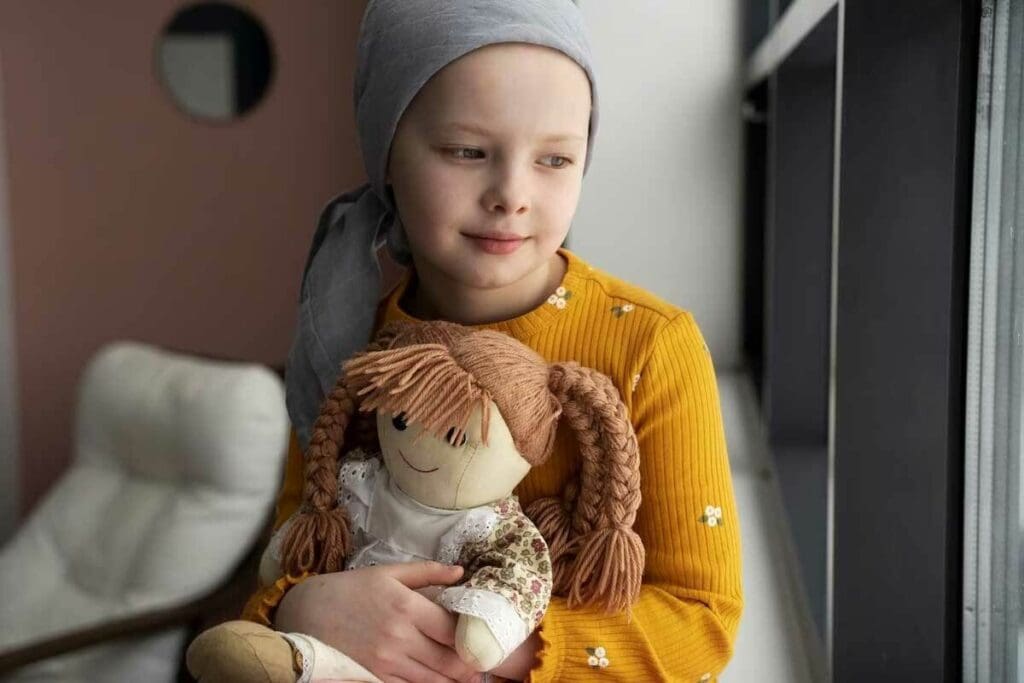Last Updated on November 20, 2025 by Ugurkan Demir

Childhood leukemia is a serious illness that affects many families. Acute lymphoblastic leukemia (ALL) is the most common type, making up about 75 percent of cases.
Liv Hospital’s team is committed to caring for families through this tough time. They offer the latest medical knowledge and support.
It’s important to know about the different types of childhood leukemia and their symptoms. This knowledge helps in early detection and treatment.

Leukemia is a cancer that starts in the blood-making cells. These cells are found in the bone marrow and lymphatic system. It messes up how blood cells are made, causing health problems in kids.
Leukemia in kids means white blood cells grow wrong. These cells help fight off infections. Acute Lymphoblastic Leukemia (ALL) is the most common type in kids. It’s also known as ALL.
Leukemia can be different based on the blood cell type and how fast it grows. Symptoms include persistent fatigue, frequent infections, and easy bruising. Knowing these symptoms helps find and treat leukemia early.
Childhood leukemia is rare but the most common cancer in kids. The American Cancer Society says it makes up about 30% of all childhood cancers. It happens more in some ages than others.
Knowing about childhood leukemia is key. It helps parents and doctors work better together. This can lead to better diagnosis and treatment for kids.

It’s important to know the different types of leukemia in kids. This knowledge helps doctors find and treat the disease better. Leukemia is divided into types based on the cells it affects and how fast it grows.
Leukemia is mainly split into acute and chronic types. Acute leukemia grows fast and needs quick treatment. Chronic leukemia grows slower. In kids, the main types are Acute Lymphoblastic Leukemia (ALL), Acute Myeloid Leukemia (AML), Chronic Myeloid Leukemia (CML), and Juvenile Myelomonocytic Leukemia (JMML).
The type of blood cell affected helps decide the treatment. For example, ALL affects lymphoid cells, and AML affects myeloid cells. Knowing this is key for the right treatment plan.
Leukemia types vary by age in kids. ALL is most common in kids aged 2 to 5. AML can happen at any age but is more common in babies and teens.
| Type of Leukemia | Age Group Most Affected | Characteristics |
| Acute Lymphoblastic Leukemia (ALL) | 2-5 years | Affects lymphoid cells, most common in children |
| Acute Myeloid Leukemia (AML) | Infants and teenagers | Affects myeloid cells, more aggressive than ALL |
| Chronic Myeloid Leukemia (CML) | Rare in children | Develops slowly, associated with the Philadelphia chromosome |
| Juvenile Myelomonocytic Leukemia (JMML) | Typically under 4 years | A rare form that affects myeloid cells, often associated with genetic disorders |
Knowing about leukemia types and their prevalence is key for early treatment. Each type needs a specific treatment plan.
Acute Lymphoblastic Leukemia (ALL) is the most common leukemia in kids. It affects the blood and bone marrow. It’s caused by too many immature white blood cells.
ALL is mostly found in kids aged 2 to 5. It’s a big worry for kids’ health. Boys get it more than girls, and some ethnic groups are at higher risk.
The peak age for ALL shows it’s linked to early childhood. This suggests that early development factors might cause it.
ALL’s spread varies by age, gender, and ethnicity. Studies show it’s more common in Caucasian kids. This points to possible genetic or environmental causes.
Knowing these patterns helps find risk factors. It also helps create better treatments.
ALL isn’t just one disease; it has many subtypes. The most common is B-cell ALL, making up most cases.
Finding out the ALL subtype is key. It helps predict the outcome and pick the right treatment.
Acute Myeloid Leukemia, or AML, is a serious disease in kids. It makes up about 20% of leukemia cases in children. It can happen in babies and teenagers.
AML happens more in some age groups than others. Babies under one often have special genetic problems. Teenagers with AML might have different symptoms and biology.
AML causes abnormal cells to grow fast in the bone marrow. This can lower the number of healthy blood cells. There are many types of AML, each with its own genetic changes.
The types are labeled M0 to M7. The French-American-British (FAB) system helps doctors understand and treat each type.
AML in kids can be caused by genetics, like Down syndrome, or environmental toxins.
Knowing the risks helps doctors catch AML early. Scientists are always learning more about what causes AML in kids.
CML in children is a rare but serious condition. It needs quick diagnosis and treatment because of its unique traits. Unlike common acute leukemia, CML affects white blood cells slowly.
In kids, CML shows unique signs that set it apart from other leukemias. A key sign is the Philadelphia chromosome. This genetic change happens when chromosomes 9 and 22 swap places.
The Philadelphia chromosome is key for diagnosing CML. It leads to a fusion gene called BCR-ABL. This gene is vital in CML’s growth and spread.
The Philadelphia chromosome is not just a sign; it’s also a target for treatment. The BCR-ABL gene acts like a tyrosine kinase, helping cells grow and live longer. Knowing CML’s genetics has led to new treatments.
“The discovery of the Philadelphia chromosome and its role in CML has revolutionized the treatment of this disease, bringing new hope to patients and their families.”
Treatment for CML in children has changed a lot with the use of tyrosine kinase inhibitors (TKIs). TKIs, like imatinib, dasatinib, and nilotinib, target the BCR-ABL tyrosine kinase. This stops leukemic cells from growing.
In summary, CML in children, though rare, needs a detailed approach to diagnosis and treatment. The Philadelphia chromosome is a major factor in both diagnosis and treatment. Thanks to ongoing research and new treatments, the future looks brighter for kids with CML.
JMML is a rare leukemia that mainly affects young children. It’s different because it grows fast and fills the bone marrow and blood with too many cells.
JMML is rare, making up about 2-3% of childhood leukemias. It’s known for hepatosplenomegaly, lymphadenopathy, and high white blood cell counts. It’s hard to spot early because it doesn’t show clear signs.
Most kids get JMML between 1 to 4 years. It’s more common in boys under 3. Spotting symptoms early is key to helping them.
Finding JMML can be tough because it doesn’t show clear signs. Doctors use blood tests, bone marrow biopsy, and genetic tests to diagnose it. These tests look for specific genetic changes.
| Diagnostic Criteria | Description |
| Blood Tests | Reveal high white blood cell count and other abnormalities |
| Bone Marrow Biopsy | Shows infiltration of myeloid cells |
| Genetic Analysis | Identifies mutations in genes such as PTPN11, KRAS, and NRAS |
Doctors need to know about JMML’s special traits and how hard it is to diagnose. This helps them make the right diagnosis and treatment plan.
MPAL is a rare leukemia that shows traits of both lymphoid and myeloid cells. It needs a careful diagnosis and treatment plan. This is because it has both lymphoid and myeloid markers on its cells.
Mixed-Phenotype Acute Leukemia is unique because it has markers from more than one lineage. This makes it different from other leukemias. Its mixed traits make diagnosing and treating it harder.
The cells in MPAL can have markers from both lymphoid and myeloid lines. Or, they might not clearly fit into one lineage. This means doctors need to do a detailed test to figure out the leukemia type and plan the treatment.
To diagnose MPAL, doctors look for specific markers on the cells. The World Health Organization (WHO) has rules for diagnosing MPAL. These rules include finding both lymphoid and myeloid markers on the cells.
| Marker | Description | Significance in MPAL |
| CD19 | Lymphoid marker | Indicates lymphoid lineage |
| CD33 | Myeloid marker | Indicates myeloid lineage |
| CD13 | Myeloid marker | Supports myeloid lineage involvement |
Treating MPAL is tough because of its complex nature and lack of standard treatments. Doctors often mix treatments for ALL and AML, based on the patient’s disease.
Treatment approaches may include:
The treatment choice depends on the patient’s age, health, and disease details. A team effort is key to managing MPAL well.
It’s important to know the signs of leukemia in kids to catch it early. Leukemia in children can show up in many ways, making it hard to spot. These symptoms can look like other common illnesses.
A persistent fever is a common sign of leukemia in kids. This fever might come and go or stay for a long time. It often comes with other signs of infection.
Fever Patterns to Watch For:
A study found that fever is a common first sign in kids with leukemia. It’s often mistaken for a viral infection.
“Fever, when present, is often one of the earliest symptoms, highlighting the need for vigilant monitoring.”
Kids with leukemia might bruise easily and bleed more. This is because they have low platelet counts. Symptoms include:
| Symptom | Description |
| Easy Bruising | Bruises appear without significant trauma |
| Nosebleeds | Frequent or prolonged nosebleeds |
| Bleeding Gums | Gums bleed easily, even when brushing |
Leukemia affects blood cell production, including platelets. This leads to bruising and bleeding.
Bone and joint pain are big signs of leukemia in kids. This pain comes from leukemia cells in the bone marrow.
Common Areas Affected:
Parents should watch for these symptoms. If they last or come with other illness signs, get medical help.
Leukemia shows up differently in kids as they get older. It can look like other common illnesses in young children. This makes it hard to catch early.
Toddlers with leukemia might get sick a lot, bruise easily, or limp. They might also act differently, like being more irritable or tired. Parents and caregivers need to watch for these signs and get help if they see them.
School-age kids with leukemia might hurt in their bones or joints. They might also feel very tired, lose weight, or get sick a lot. If these problems keep happening, they need to see a doctor right away.
Teenagers with leukemia might feel very tired, lose weight, or have bleeding gums. They could also have night sweats or keep getting sick. It’s key for teens, parents, and doctors to know these signs to catch leukemia early.
The exact cause of leukemia in kids is not fully understood. But, research has found several risk factors that play a part. Knowing these factors helps in finding better ways to prevent and treat the disease.
Some genetic disorders make kids more likely to get leukemia. For example, kids with Down syndrome are at higher risk. Other conditions like Li-Fraumeni syndrome and ataxia-telangiectasia also increase the risk.
Genetic mutations can be passed down or caused by environmental factors. Genetic testing is becoming key in managing childhood leukemia.
| Genetic Disorder | Associated Leukemia Risk |
| Down Syndrome | Increased risk of acute leukemia |
| Li-Fraumeni Syndrome | Higher risk of various cancers, including leukemia |
| Ataxia-Telangiectasia | Increased risk of leukemia and lymphoma |
Some environmental factors can raise the risk of childhood leukemia. Ionizing radiation is a known risk. Kids exposed to radiation from nuclear accidents or medical procedures face a higher risk.
“Exposure to ionizing radiation is a well-established risk factor for leukemia. The risk is dose-dependent, with higher doses associated with a greater risk of developing the disease.”
Nature Reviews Cancer
Chemicals like benzene also increase leukemia risk. Research is ongoing to understand the role of pesticides and other chemicals in childhood leukemia.
The immune system’s development is key in leukemia. Problems in immune cell growth can lead to cancer cells. Studying how the immune system grows and how to control it is vital for new treatments.
Research on the immune system’s role in leukemia has led to immunotherapies. These treatments aim to use the body’s immune system to fight leukemia cells.
Spotting leukemia signs in kids is key to early treatment. Catching it early can greatly improve their chances of beating the disease.
Keep a close eye on your child’s health. If you see any odd symptoms, get them checked by a doctor. Look out for these signs:
If your child shows any of these signs, see a doctor right away.
Diagnosing leukemia involves several tests. It starts with a complete blood count (CBC). This test checks for odd white, red blood cells, and platelets.
After the CBC, more tests follow. These include:
It’s important to understand blood test results. A CBC can show odd blood cell counts, which might mean leukemia. Look for these signs:
Talking to a healthcare provider about these results is vital. They can explain what they mean and what to do next.
Families dealing with childhood leukemia can find help through many resources. The Leukemia & Lymphoma Society (LLS) and the Children’s Leukemia Foundation offer a lot of support. They provide information, emotional help, and guidance during treatment.
Looking for help? The LLS website is a great place to start. It has lots of info on leukemia, treatments, and clinical trials. Support groups, both online and in-person, help families connect with others who understand their journey.
There’s more help than just medical care. Many groups offer financial aid, counseling, and advocacy. By using these resources, families can handle the tough parts of childhood leukemia better. They can find the support they need during this hard time.
In children, the most common leukemia types are Acute Lymphoblastic Leukemia (ALL) and Acute Myeloid Leukemia (AML). ALL is the most common.
Infants with leukemia might show fever, bruising, and bleeding. They may also have pale skin due to anemia.
Toddlers with leukemia might have persistent fever, bone pain, and swelling in the abdomen. They also might bruise easily and bleed.
Doctors use physical exams, blood tests, bone marrow aspiration, and imaging to diagnose leukemia in children.
Genetic predispositions, environmental exposures, and immune system issues can increase the risk of leukemia.
Yes, many children with leukemia can be cured with today’s treatments. It depends on the leukemia type and subtype.
The Philadelphia chromosome is linked to Chronic Myeloid Leukemia (CML) and some ALL cases. It’s a genetic marker.
MPAL is a rare leukemia with both lymphoid and myeloid cell traits. It’s hard to diagnose and treat.
Yes, ionizing radiation, some chemicals, and pesticides can raise the risk of leukemia.
Leukemia shows different signs in different ages. Infants, toddlers, school-age kids, and teens have unique symptoms.
JMML is a rare leukemia in young children. It’s marked by myeloid cell growth and genetic mutations.
Subscribe to our e-newsletter to stay informed about the latest innovations in the world of health and exclusive offers!